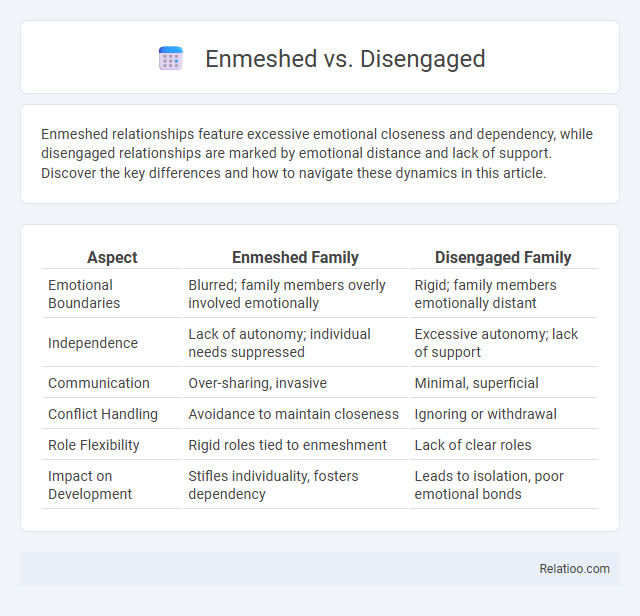Enmeshed relationships feature excessive emotional closeness and dependency, while disengaged relationships are marked by emotional distance and lack of support. Discover the key differences and how to navigate these dynamics in this article.
Table of Comparison
| Aspect | Enmeshed Family | Disengaged Family |
|---|---|---|
| Emotional Boundaries | Blurred; family members overly involved emotionally | Rigid; family members emotionally distant |
| Independence | Lack of autonomy; individual needs suppressed | Excessive autonomy; lack of support |
| Communication | Over-sharing, invasive | Minimal, superficial |
| Conflict Handling | Avoidance to maintain closeness | Ignoring or withdrawal |
| Role Flexibility | Rigid roles tied to enmeshment | Lack of clear roles |
| Impact on Development | Stifles individuality, fosters dependency | Leads to isolation, poor emotional bonds |
Understanding Enmeshed and Disengaged Relationships
Enmeshed relationships involve overly close and intertwined emotional boundaries, where Your individuality may become blurred, leading to dependency and a lack of personal autonomy. Disengaged relationships are characterized by emotional distance and minimal interaction, resulting in isolation and difficulty in forming meaningful connections. Understanding these dynamics helps identify patterns that impact emotional health and interpersonal functioning within family or social systems.
Defining Enmeshment: Signs and Characteristics
Enmeshment is characterized by blurred boundaries between individuals, where personal autonomy is compromised in favor of excessive emotional involvement and dependency. Signs include an inability to differentiate one's feelings from others', over-involvement in each other's lives, and difficulty establishing independent identities. This dynamic contrasts with disengaged systems, where emotional distance and lack of support dominate, emphasizing the importance of balanced boundaries within family or relational systems for healthy functioning.
Disengagement Explained: Key Indicators
Disengagement in family systems is characterized by emotional distance, lack of communication, and minimal involvement between members, often leading to isolation and weakened relational bonds. Key indicators include limited sharing of personal feelings, avoidance of conflicts, and inadequate support during crucial life events. This contrasts with enmeshed systems, where boundaries are blurred and over-involvement occurs, and balanced systems that maintain healthy emotional connections.
The Roots of Enmeshed and Disengaged Dynamics
Enmeshed family systems emerge from blurred boundaries where individual autonomy is overshadowed by over-involvement, often rooted in childhood experiences of emotional dependency or parental control. Disengaged systems arise from rigid boundaries that foster emotional distance and isolation, frequently linked to early neglect or parental unavailability. Understanding these roots helps you identify patterns that impact relationship dynamics and personal growth.
Emotional Impact on Individuals and Families
Enmeshed family systems create intense emotional entanglement, often leading Your sense of identity to become blurred with others, fostering anxiety and difficulty in setting boundaries. Disengaged family systems result in emotional distance and isolation, causing feelings of loneliness, detachment, and a lack of support during stressful times. Understanding these dynamics within a system is crucial for addressing emotional challenges and promoting healthier relationships in families.
Communication Patterns in Each Relationship Style
Enmeshed relationships exhibit intense communication patterns where boundaries are blurred, causing your emotions and thoughts to be deeply intertwined with others'. Disengaged relationships feature minimal communication, characterized by emotional distance and avoidance, making interactions sparse and superficial. In system relationships, communication flows dynamically among members, balancing individual expression with group cohesion to maintain overall stability and adaptability.
Common Causes and Contributing Factors
Enmeshed family systems often result from blurred boundaries and excessive emotional involvement, driven by overprotectiveness and a need for control. Disengaged families typically emerge due to neglect, emotional distance, or lack of communication, fostering isolation and limited support. Systemic patterns in both types are influenced by parental conflict, unresolved trauma, and inconsistent attachment styles impacting family dynamics.
Effects on Personal Boundaries and Autonomy
Enmeshed family systems blur personal boundaries, leading to diminished autonomy as individuals struggle to separate their identity from the group. Disengaged systems establish rigid boundaries, resulting in emotional distance and limited support, which can hinder personal growth and secure autonomy. Balanced systems maintain clear but flexible boundaries, fostering healthy independence and mutual respect that support both personal autonomy and connectedness.
Healing and Creating Healthy Connections
Enmeshed relationships often lack boundaries, leading to emotional overdependence that hinders healing and personal growth. Disengaged systems create emotional distance and isolation, preventing meaningful connection and fostering unresolved pain. Your journey to healing involves establishing balanced boundaries within the system, allowing for healthy interdependence and authentic connections.
Professional Support and Coping Strategies
Professional support for enmeshed systems emphasizes establishing healthy boundaries and promoting individual autonomy, while disengaged systems benefit from strategies that encourage emotional connection and communication. Coping strategies tailored to each system include therapy focused on boundary-setting for enmeshed relationships and interventions aimed at fostering intimacy and engagement in disengaged systems. Your ability to recognize these dynamics allows for targeted professional guidance and effective coping mechanisms.

Infographic: Enmeshed vs Disengaged
 relatioo.com
relatioo.com